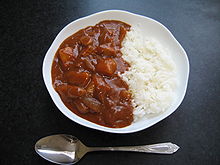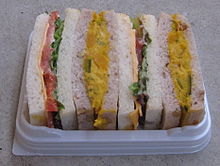- Yōshoku
-
In Japanese cuisine, yōshoku (洋食 western food) refers to a style of Western-influenced cooking which originated during the Meiji Restoration. These are primarily Japanized forms of European dishes, often featuring Western names, and usually written in katakana.
Contents
History
At the beginning of the Meiji Restoration, national seclusion was eliminated, and the Meiji Emperor declared Western ideas as means to Japan's future progress. As part of the reformations, the Emperor lifted the ban on red meat and promoted Western cuisine, which was viewed as the cause of the Westerner's greater physical size. Yōshoku was thus created, and as a result of its origins, relies on meat as a common element, unlike the typical Japanese cuisine at the time. In the past, the term yōshoku was for western cuisine, regardless of the country of origin (as opposed to French, English, Italian etc.), but people became aware of differences between European and Yōshoku due to the opening of many European restaurants serving more authentically European (non-japanized) food in the 1980s.[1]
Earlier dishes of European origin – notably those imported from Portugal in the 16th century such as tempura, are not, strictly speaking, part of yoshoku, which refers only to Meiji-era food. However, some yōshoku restaurants serve tempura.
Yoshoku varies in how japanized it is: while yōshoku may be eaten with a spoon (as in カレー, karē, curry), paired with bread or a plate of rice (called ライス, raisu), and written in katakana to reflect that they are foreign words, some have become sufficiently Japanified that they are often treated as normal Japanese food (washoku): served alongside rice and miso soup, and eaten with chopsticks. An example of the latter is katsu, which is eaten with chopsticks and a bowl of rice (ご飯, gohan, rice), and may even be served with traditional Japanese sauces such as ponzu or grated daikon, rather than katsu sauce. Reflecting this, katsu is often written in hiragana as かつ, as a native Japanese word, rather than as カツ (from カツレツ, katsuretsu, "cutlet").
European foods that are identified as yōshoku have in turn spread to China and Korea from Japan, where they are also called "Yoshoku".
Overview
Jihei Ishii, author of the 1898 The Japanese Complete Cookbook (日本料理法大全), states that: "Yōshoku is Japanese food."
Created in the Meiji era, it may not have as long a history as Washoku (Japanese traditional dishes), yet there are yōshoku dishes which have themselves become traditional Japanese fare. Yōshoku is considered a field of Japanese cuisine, including such typical adapted meals as katsu, beefsteak, korokke, naporitan, Hayashi rice and curry rice (Japanese curry). Many of these meals are even assumed to be washoku.
Yōshoku began by altering Western recipes for lack of information about foreign countries’ cuisine, or adaptions to suit local tastes, but over time, yōshoku also evolved dishes that were not at all based on European foods, such as chicken rice and omurice (omelette rice). Elaborate sauces were largely eliminated, replaced with tomato ketchup, demi-glace sauce, and worcester sauce.
During Japan's modernization, yōshoku was often too expensive for the common man. But after World War II, ingredients for yōshoku became more widely available, and its popularity grew.
A yōshokuya (洋食屋) is a restaurant where yōshoku dishes are served. During Japan's rapid economic growth people began eating yōshoku in department store restaurants, but now family restaurants such as Denny's and Saizeriya are considered essential yōshoku establishments.[1] In addition, there are also a number of upscale yōshoku restaurants in Japan, such as Shiseido Parlor in Ginza and Taimeiken in Nihonbashi.
Variations
- Curry
- Stew
- Korokke
- Chicken nanban: fried chicken seasoned with vinegar and tartare sauce
- Piroshiki
- Fried
- Deep-fried oysters (kakifurai)
- Fried prawn (ebifurai)
- Beefsteak: Steak with Japanese-style sauce
- Meuniere
- Spaghetti
- Cutlet
- Tonkatsu
- Fried chicken (chicken katsu)
- Beef cutlet (beef katsu)
- Ham katsu
- Menchi katsu
- Turkish rice (torukorice): Pilaf flavored with curry, naporitan spaghetti and tonkatsu with Demi-glace sauce
- Omurice
- Steak
- Mikkusu sando (ミックスサンド) – assorted sandwiches, especially egg salad, ham, and cutlet
- Gratin
- Doria: Roasted pilaf with béchamel sauce and parmigiano-reggiano
- Pilaf
See also
References
- ^ a b Norimitsu Onishi (2008-03-26). "Spaghetti Stir-Fry and Hambagoo: Japan Looks West". New York Times. http://www.nytimes.com/2008/03/26/dining/26japan.html?scp=4&sq=japan%20western%20cooking&st=cse. Retrieved 2008-09-11.
Categories:
Wikimedia Foundation. 2010.



